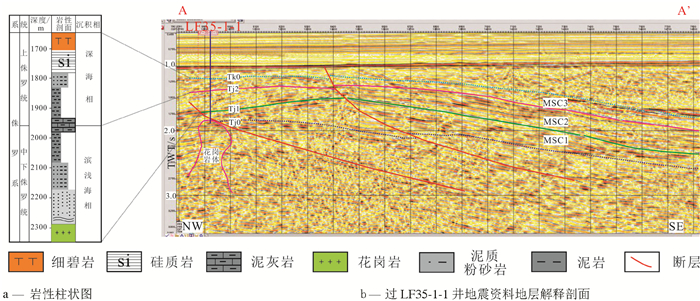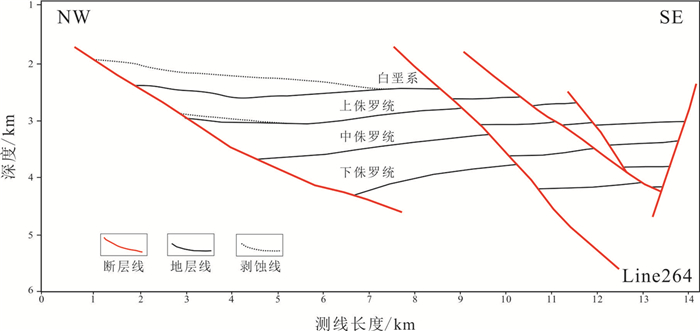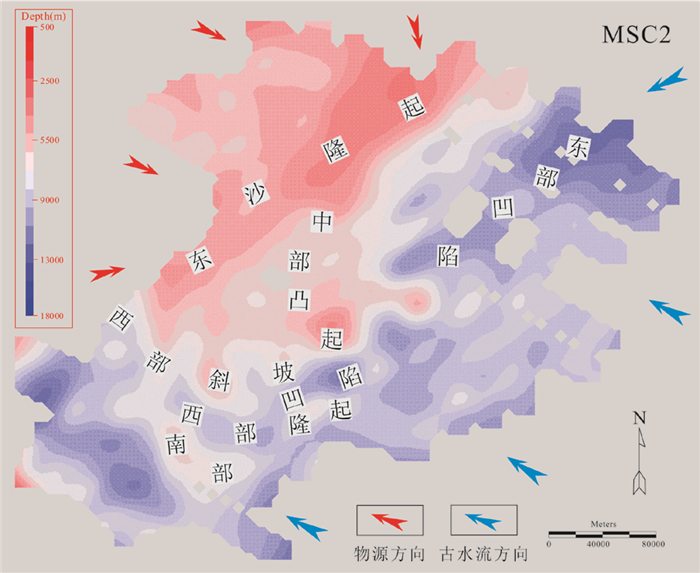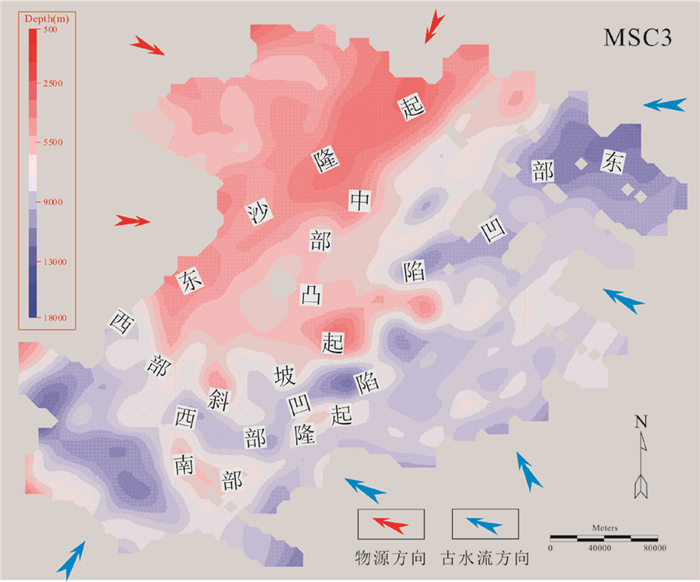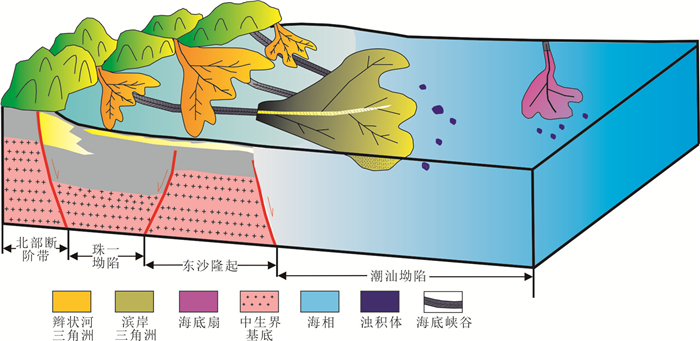Paleogeomorphic features and sedimentary facies model of Jurassic strata in Chaoshan sub-basin, northern South China Sea
-
摘要:
南海北部潮汕坳陷中生界极具油气勘探潜力;综合运用最新采集的地震资料结合测井数据,在侏罗纪地层精细划分的基础上,通过对目的层剥蚀量计算,对侏罗系古地貌进行了恢复;利用残留地层的沉积相标志分析结果,建立了潮汕坳陷侏罗系沉积模式。结果表明,在早侏罗世末期和中侏罗世末期,地层遭受剥蚀改造;古地貌各要素对沉积体系发育的影响,古隆起(凸起)指明了沉积物的来源和方向;古海底峡谷是沉积物从物源区搬运到沉积区的重要运移通道;斜坡带为重要的沉积场所,并对储层的品质和规模有巨大影响,制约着盆地可容纳空间的大小;盆底的地貌形态控制着沉积体形态和产状。研究结果表明,古地貌恢复后的各要素在时空上的有效配置关系是准确把握沉积体系展布特征及范围的关键因素,对沉积储层及烃源岩的控制作用非常明显。该结论对侏罗系下一步勘探及有利储层预测有积极意义。
Abstract:The Mesozoic strata in the Chaoshan sub-basin of northern South China Sea have rich oil and gas resources. Seismic data and well logging data were used in combination with fine stratigraphic division and denudation calculation to restore paleogeomorphology of the Jurassic sedimentary strata.On the basis of sedimentary facies marker analysis of residual strata, a Jurassic sedimentary model was established. The Jurassic strata suffered denudation alterations at the end of Early Jurassic and Middle Jurassic. Various elements of paleogeomorphology influenced sedimentary system development. Ancient uplift (bulge) indicated the source and direction of sediments. The ancient sea bottom canyon was an important transport passage between source and sedimentation. The slope zone was an important deposition site and had great influence on the quality and size of reservoirs, thus restricting the accommodation space of the basin. The basin bottom (depression) topography controlled the morphology and occurrence of sediments and influenced the quality and size of source rocks. Effective combination of all the elements of paleogeomorphology in time and space seems to be the key to accurate determination of the distribution and range of a sedimentary system, and its control of sedimentary reservoirs and source rocks is very obvious. The conclusion has positive significance for the next exploration and favorable reservoir prediction of the Jurassic strata.
-
Keywords:
- sedimentary faces /
- depositional characteristics /
- Chaoshan Sub-basin /
- Jurassic
-
1. 引言
南海南、北部陆缘中、新生界角度不整合的广泛发育以及上白垩统的普遍缺失等现象可能与太平洋板块向华南的俯冲带在晚白垩世发生后撤而引起华南陆缘均衡抬升有关,故华南陆缘在发生张裂之前的晚白垩世可能整体为区域抬升遭受剥蚀、局部陆-陆碰撞缝合的构造格局(王长势,2015)。潮汕坳陷位于南中国海东北部的陆缘陆坡区珠江口盆地的东南部(图 1),坳陷的整体呈北东向展布,其西北接东沙隆起,东北接台西南盆地,西南侧为白云凹陷,东南侧则是南部隆起带,面积约为1.56× 104 km2,水深为200~3000 m,潮汕坳陷中生界最大厚度可达5500 m(蔡乾忠等,2007;周蒂等,2007;郝沪军等,2009)。2003年9月中国海洋石油总公司在潮汕坳陷北坡构造带上钻探的LF35-1-1井,直接证实了潮汕坳陷存在海相侏罗—白垩纪地层,并且钻遇了侏罗系有机质丰度高且成熟度高的烃源岩,这不仅证明了中生代残留盆地的存在,而且表明其已具备油气聚集成藏的烃源条件和形成多种类型油气藏的条件(陈洁等,2007;何家雄等, 2009, 2012;杨树春等,2009;段九春等,2012;陆宝亮等,2014;李文浩等,2014)。进行古地貌恢复不仅可以有效揭示物源供给的形式和波及范围,还能直观描述沉积物搬运通道以及平面和纵向展布特征,而且在一定程度上影响沉积、沉降中心的迁移规律,并一定程度的影响油气勘探工作中储层分布特征及油气储盖组合等(陈树光等,2015)。在研究潮汕坳陷中生界侏罗系沉积体系发育演化的过程中,古地貌对沉积演化的影响作用是不可忽视的。基于潮汕坳陷侏罗系沉积系统目前的研究现状,对潮汕坳陷侏罗系海相沉积层序进行古地貌恢复,进一步深化侏罗纪储层沉积机理和储层展布特征,进而明确沉积体系演化特征和沉积模式等。潮汕坳陷目前中生界尚无重大油气发现,且国内外尚无可以借鉴的研究案例,本文对中生界侏罗系沉积模式进行了针对性的研究工作,力争为该地层的油气勘探工作提供一定参考,早日实现油气突破。
2. 潮汕坳陷侏罗系构造层序地层格架
根据研究区唯一钻井(LF35-1-1井)显示中—上侏罗统上部为灰黑色纹层状泥岩及泥质粉砂岩夹硅质岩,含少量泥晶灰岩;下部为灰黑色纹层状泥岩及泥质粉砂岩夹砂岩、灰岩,泥岩中富含有机质碎屑。通过和地震剖面综合对比研究分析,潮汕坳陷侏罗纪地层在地震剖面上可以明确识别出4个反射界面和3个构造层(图 2),4个反射界面即:Tj0(侏罗系底界面)、Tj1(下侏罗统底界面)、Tj2(中侏罗统底界面)和Tk0(上侏罗统底界面);3个构造层即:Tj0-Tj1(下侏罗统构造层)、Tj1-Tj2(中侏罗统构造层)和Tj2-Tk0(上侏罗统构造层),分别对应MSC1、MSC2和MSC3。
Tj0-Tj1(MSC1)构造层顶界面为区域性似平行整合面,其上为低频强振幅连续反射,其下为中振幅断续反射不整合面,构造层底界面为侏罗系与基底的分界面,界面由两个平行的强振幅反射构成,构造层内地震反射特征为清晰的地震反射同相轴,中频强振幅,连续性好的亚平行反射(图 2b);本段沉积主要为滨浅海相,岩性剖面显示本段下部岩性主要以变质砂岩和花岗岩为主,显示有火成岩侵入现象(图 2a)。
Tj1-Tj2(MSC2)构造层顶界面为假合面,其上以波状变振幅反射为主,对下伏地层的削截现象十分普遍,早期断层通常截止在这一层面附近,代表了这一时期前后,潮汕坳陷发生过规模较大的构造运动,对整个潮汕坳陷的构造格局产生了较大的影响,内部地震反射特征为中频、强振幅、连续性好和亚平行反射特征(图 2b);本段沉积主要为滨浅海相,岩性剖面显示本段下部岩性主要以变质砂岩和粉砂质泥岩为主,上部岩性主要为泥岩(图 2a)。
Tj2-Tk0(MSC3)构造层顶界面为不整合界面,底界面可见顶超和削截,呈断续状波阻抗界面,其界面之上以波状振幅反射。内部反射特征为显示中-高频连续反射,显示为该时期曾经较为的连续沉积(图 2b);本段沉积主要为深海相沉积,岩性剖面显示本段主要以泥岩为主,下部岩性主要以泥岩和泥灰岩为主,上部岩性主要为硅质岩(图 2a)。
3. 古地貌恢复
3.1 沉积地层的残余厚度
利用地震数据体准确标定地震层序格架,结合钻井资料,确保序地层解释的合理和准确闭合,通过VSP速度进行时深转换,读取深度值,得到MSC1、MSC2和MSC3三个层位厚度等T0图,明确目前地层残余厚度图和分布范围,为后续的剥蚀厚度恢复奠定基础。
3.2 地层剥蚀厚度恢复
依据潮汕坳陷侏罗纪地层的构造结构特征,采用了参考层趋势延伸法结合沉积速率法对研究区的侏罗纪地层剥蚀量分别进行了恢复。沉积速率法可以基本定量的恢复剥蚀量,其基本原理为,利用平行不整合上、下地层的沉积速率和剥蚀速率,以绝对地质年龄为时间边界,来研究和恢复地层剥蚀厚度。本次地层剥蚀厚度研究主要选取研究区中部凸起方向的8条主测线(LIN264、LIN256、LIN238、LIN254、LIN232、LIN221、LIN200、LIN184)的二维地震解释剖面及其层位数据,在综合分析区域构造和演化特征的基础之上,对上侏罗统和中侏罗统分别应用参考厚度变化率法和沉积速率法来估算其剥蚀厚度。以Line264为例(图 3),分析上侏罗统和中侏罗统的剥蚀厚度。在上侏罗统顶界面任意取一个参考点,上侏罗统的沉积时间为163.5 Ma,中侏罗统的沉积时间为174.1 Ma,结合上侏罗统的残余厚度和中侏罗统的沉积厚度,可计算出上侏罗统和中侏罗统的沉积速率比值,从而得到上侏罗统和中侏罗统的剥蚀厚度。从Line264线上侏罗统和中侏罗统地层剥蚀厚度显示,中侏罗统剥蚀厚度较小,靠近西部断裂有所剥蚀,剥蚀厚度为400 m左右,而上侏罗统剥蚀厚度较大,靠近西部断裂附近剥蚀厚度可达1250 m。最后,综合分析各条测线上侏罗统和中侏罗统剥蚀厚度图的基础上,计算出上侏罗统和中侏罗统剥蚀厚度等值线图,为下一步恢复古地貌打下基础。通过全研究区剥蚀厚度定量恢复结果表明,南海北部自晚三叠世以后的印支运动以来,潮汕坳陷的构造活动并非简单的水平抬升和隆升,是一种具有继承性抬升并伴有强烈的挤压叠并加拉分构造变形,剥蚀量呈现“北强南弱”的特点。
3.3 地层压实作用及古水深校正
地层压实作用及古水深校正时古地貌恢复中不能回避的问题。地层的压实作用主要考虑潮汕坳陷侏罗系恢复区的可能沉积相特征以及目的层的砂-泥比值,研究则根据地震相特征转换沉积相及亚相,并和实际钻井位沉积相剖面、地震相剖面特征进行类比,合理估算出各层砂泥岩的含量,同时利用外延法。利用钻井上岩相资料等进行综合分析估算出分布在全研究区范围内的各控制点的古水深。通过以上恢复过程,对研究区选取的366个控制点的数据进行分层系落实,依据南海北部海域公认侏罗系年龄值和借助参考区域砂泥岩的密度以及压实系数等参数对模拟软件进行设置。利用回剥原理并参考剥蚀量定量恢复数据,借助盆地古地貌恢复综合模拟软件(Seino)计算,得到了研究区侏罗纪层序的古地貌图(图 4,图 5,图 6)。
3.4 沉积地层古地貌及其特征
从沉积地层古地貌恢复结果中可识别出研究区古地貌,包括隆起、凸起、斜坡和凹陷等构造单元,这些单元在不同时期表现形式和展布范围不尽相同,但却继承性发育。其中东沙隆起一直存在且面积最大,并持续提供着研究区的物源。从图 4显示,潮汕坳陷在早侏罗世沉积时期东沙隆起和中部凸起连为一体,南部隆起幅度不高且面积较小,而此时,东部凹陷沉积范围最大,埋藏最深,是潮汕坳陷下侏罗统的的沉积沉降中心,西部凹陷相对范围较小,沉积厚度也较浅;从图 5显示,潮汕坳陷在中侏罗世沉积时期东沙隆起和中部凸起相对较为独立,东沙隆起隆升幅度没有早侏罗世沉积时期高,南部隆起展布面积继续萎缩,可能与这时期大规模的海侵有关,而此时,东部凹陷和西部凹陷连为一体,海相泥岩最为发育,且沉积范围最大;从图 6显示,潮汕坳陷在中侏罗世沉积时期东沙隆起和中部凸起又互为一体,东沙隆起隆升幅度比中侏罗世沉积时期高,南部隆起展布面积扩张,可能与这时期大规模的海退有关,而此时,东部凹陷和西部凹陷被中部凸起分隔开来,南部隆起隆升幅度有所增加。海底峡谷在研究区广泛发育于中部凸起的东边和西边,数量较多,单个规模也较大,但仅仅依靠古地貌恢复难以准确的识别;通过借助2D地震属性和地震剖面对研究区进行了综合分析与识别,结果表明:在中部凸起西北侧海底峡谷较为发育,这也是西部凸起和西部斜坡海底扇在欠补偿沉积环境下较为发育的原因。
4. 潮汕坳陷侏罗系沉积模式
潮汕坳陷在晚三叠世末期,以雅鲁藏布江缝合带为遗迹的新特提斯洋在不断北移的冈瓦纳大陆北缘开始扩张,属于特提斯构造域东延部分的原始华南大陆南缘此时也下陷并接受沉积,海水由南向北侵入,沉积了一套滨浅海相及海陆交互相的碎屑岩。至中—晚侏罗世,库拉—太平洋板块向北西俯冲至亚洲大陆之下,由于区域挤压应力的作用,本区发生挤压、隆起和坳陷,并形成一系列NE向的宽缓长轴褶皱。到了晚侏罗世末—早白垩世初,新特提斯洋再次强烈拉张,本区开始沉降,海水再次由南向北侵入,并沉积了一套滨浅海相地层,不整合超覆于上三叠统—下侏罗统之上(夏戡原等,2000;钟大赉等,2002;邵磊等,2007;吴国瑄等,2007)。
在前人研究的基础上,综合利用研究区钻井、地震等资料,通过岩相、地震相标志分析,结合古地貌分析,潮汕坳陷在侏罗纪沉积时期,发现不同的沉积相发育于不同的古地理单元之上,其中,滨岸三角洲主要发育于中部凸起西北部的和东沙隆起中部和西部缓坡带附近,海底扇主要发育于东部凹陷的北部,而浊积体主要发育于滨岸三角洲前缘的东南部和深水扇前缘南部区域;综上所述,可以建立潮汕坳陷侏罗系沉积模式(图 7):侏罗纪时期,潮汕坳陷主要发育滨岸三角洲和海底扇和浊积体沉积,东部凹陷和西部凹陷发育南、北双物源体系,由于是整体在欠补偿沉积环境,物源供给相对不足,沉积物的有效供给除了通过古海底峡谷外,还在西部斜坡带,由于坡度较缓,沉积物搬运距离相对较长,发育滨岸三角洲,沉积了一套薄层的、磨圆度相对较好的含砂岩及细砂、粉砂岩;而在东部凹陷,由于北部物源在相对海平面快速下降时期,大量的沉积物由陆架边缘三角洲经过海底峡谷以重力流的方式搬运到坳陷的深部区域,快速堆积形成盆底深水扇,在水动力的作用条件下,形成一套多期次叠加的砂砾岩和含砾砂岩与海相泥岩互层的沉积组合;滨岸三角洲前缘向前快速推进,朵叶向前延伸较远时,在三角洲前缘向坳陷延伸范围,形成数量众多,面积不一的重力作用的滑塌浊积体沉积,由于海水的浮力作用,深水扇端亚相前缘易于滑塌形成小规模的浊积体,该浊积体发育规模普遍不大,物源通道的发育规模对其影响作用十分明显,主要在潮汕坳陷东部凹陷深水扇前缘附近发育。
5. 结论
(1)在潮汕坳陷侏罗系建立层序地层格架的基础上,采用参考层厚度变化法和沉积速率法来恢复其剥蚀厚度,全区剥蚀厚度定量恢复结果表明,研究区在晚三叠世以后的印支运动在潮汕坳陷并不是简单的水平抬升,是一种具有继承性抬升并伴有强烈的挤压叠加拉分构造变形,剥蚀呈现”北强南弱“的特点。
(2)潮汕坳陷古地貌各要素对沉积体系的发育产生巨大影响,古隆起(凸起)指明了沉积物的来源和方向;古海底峡谷是物源区与沉积区的重要搬运通道;斜坡带为重要的沉积物堆积场所;凹陷地貌则控制着沉积体形态和产状。
(3)建立潮汕坳陷侏罗系沉积模式:侏罗纪时期,潮汕坳陷主要发育滨岸三角洲和海底扇和浊积体沉积,古地貌的各要素在时空配置的有效性是准确把握沉积体系展布特征及范围的关键。
-
-
Can Qianzhong. 1998. Primary hydrocarbon-bearing basins and the pool-forming conditions in China seas and adjacent regions[J]. Marine Geology & Quaternary Geology, 1998(4):1-10(in Chinese with English abstract). http://en.cnki.com.cn/Article_en/CJFDTOTAL-HYDZ804.000.htm
Chen Shuguang, Ren Jianye, Wu Feng, Cui Can, Zhang Jianli. 2015.Palaeogeomorphic recovery and its application in Shabei Area, central Bohai Depression[J]. Special Oil & Gas Reservoirs, 22(2):52-55(in Chinese with English abstract). http://en.cnki.com.cn/Article_en/CJFDTOTAL-TZCZ201502012.htm
Chen Jie. 2007. Geophysical characteristics of the Chaoshan depressionand its hydrocarbon exploration potential[J]. Progress in Geophysics, 22(1):147-155(in Chinese with English abstract). http://www.cnki.com.cn/Article/CJFDTotal-DZLP200702004.htm
Duan Jiuchun, Mi Huifen. 2012. Seismic Facies and Sedimentary Facies Study of Mesozoic in Chaoshan Sag[J]. Resources & Industries, 14(1):106-111(in Chinese with English abstract). http://www.wanfangdata.com.cn/details/detail.do?_type=perio&id=zycy201201019
Hao Hujun, Shi Hesheng, Zhang Xiangtao, Wang Tiancai, Tang Shouli. 2009. Mesozoic sediments and their petroleum geologyconditions in Chaoshan sag:a discussion based ondrilling results from the exploratory well LF35-1-1[J]. China Offshore Oil and Gas, 21(3):151-156(in Chinese with English abstract).
He Jiaxiong, Chen Shenghong, Cui Shasha, Ma Wenhong, Luan Xiwu. 2009. Early-stage prediction and evaluation of hydrocarbon source rocks in the deepbasin on the northern continental margin of the South China Sea[J]. Geology in China, 36(2):404-416(in Chinese with English abstract). http://en.cnki.com.cn/Article_en/CJFDTOTAL-DIZI200902015.htm
He Jiaxiong, Chen Shenghong, Ma Wenhong, Gong Xiaofeng. 2012.The evolution, migration and accumulation regularity of oil and gas in Zhujiangkou basin, northeastern South China Sea[J]. Geology in China, 39(1):106-118(in Chinese with English abstract). http://www.wanfangdata.com.cn/details/detail.do?_type=perio&id=zgdizhi201201011
Li Wenhao, Zhang Zhihuan, Li Youchuan, Zhang Gongcheng, Fu Ning. 2014. The development characteristics of source rocks in the main deepwater petroliferous basins of the world and their enlightenment to the study of source rocks in deep-water area of northern South China Sea[J]. Geology in China, 41(5):1673-681(in Chinese with English abstract). http://www.wanfangdata.com.cn/details/detail.do?_type=perio&id=zgdizhi201405021
Lu Baoliang, Wang Pujun, Wu Jingfu, Li Wuzhi, Wang Wanyin, Lang Yuanqiang. 2014. Distribution of the Mesozoic in the continental margin basins of the South China Sea and its petroliferous significance[J]. Petroleum Exploration And Development, 41(4):497-503(in Chinese with English abstract). http://www.wanfangdata.com.cn/details/detail.do?_type=perio&id=syktykf201404017
Qiang Kunsheng, Zhang Guangxue, Zhang Li, Lv Baofeng, Zhong Guangjian, Feng Changmao, Yi Hai, Zhao Zhongquan, Yang Zhen, Yan Wei.2018. A study of depositional characteristics of the Jurassic strata in Chaoshan Sub-basin, northern South China Sea, and its control on reservoir beds[J]. Geology in China, 45(1):48-58(in Chinese with English abstract) http://www.wanfangdata.com.cn/details/detail.do?_type=perio&id=zgdizhi201801005
Shao Lei, You Hongqing, Hao Hujun, Wu Guoxuan, Qiao Peijun, Lei Yangchang. 2007. Petrology and Depositional Environments of Mesozoic Strata in the Northeastern South China Sea[J]. Geological Review, 53(2):164-169. http://d.old.wanfangdata.com.cn/Periodical/OA000004687
Su Pibo, Liang Jianqiang, Fu Shaoying, Lü Wanjun, Gong Yuehua. 2017. Geological background and accumulation models of gas hydrate reservoir in northern South China Sea[J]. Geology in China, 44(3):415-427(in Chinese with English abstract). http://www.wanfangdata.com.cn/details/detail.do?_type=perio&id=zgdizhi201703001
Wang Changshi, Zhu Weilin, Zhong Kai, Xu Changhai. 2015. Late Cretaceous Tectonic Thrusting and Its Genesis in Northern Slope of the South China Sea[J]. Earth Science, 40(9):1505-1516. http://www.wanfangdata.com.cn/details/detail.do?_type=perio&id=dqkx201509006
Wu Guoxuan, Wang Rujian, Hao Hujun, Shao Lei. 2007. Microfossil evidence for development of marine Mesozoic in the north of south china sea[J]. Marine Geology & Quaternary Geology, 27(1):79-85(in Chinese with English abstract). http://www.wanfangdata.com.cn/details/detail.do?_type=perio&id=hydzydsjdz200701010
Xia Kanyuan, Huang Ciliu. 2000. The discovery of meso-tethys sedimentary basins in the southchina sea and their oil and gas perspective[J]. Earth Science Frontiers, 7(3):227-238(in Chinese with English abstract).
Yan Shuchun, Tong Zhigang, He Qing, Hao Jianrong. 2008. Mesozoic hydrocarbon generation history andigneous intrusion impacts in Chaoshan depression, South China Sea:A case of LF35-1-1 well[J]. China Offshore Oil and Gas, 20(3):152-156(in Chinese with English abstract). http://en.cnki.com.cn/Article_en/CJFDTOTAL-ZHSD200803002.htm
Zhong Dalai, Ding Lin, Zhang Jinjiang, Ji Jianqing. 2002. Study of orogenic belts in China:Retrospects and prospects[J]. Geological Review, 48(2):147-152(in Chinese with English abstract). http://d.old.wanfangdata.com.cn/Periodical/OA000005772
Zhou Di, Sun Zhen, Chen Hanzong. Tectonic features of World's major deep-water oil/gas fields and their enlightenment to deep-water exploration in northern South China Sea[J]. Advances in Earth Science, 2007, 22(6):561-572(in Chinese with English Abstract). http://www.wanfangdata.com.cn/details/detail.do?_type=perio&id=dqkxjz200706002
蔡乾忠. 1998.中国海域及邻区主要含油气盆地与成藏地质条件[J].海洋地质与第四纪地质, (4):1-10. http://www.wanfangdata.com.cn/details/detail.do?_type=perio&id=QK199800270735 陈洁. 2007.潮汕坳陷地球物理特征及油气勘探潜力[J].地球物理学进展, 22(1):147-155. doi: 10.3969/j.issn.1004-2903.2007.01.021 陈树光, 任建业, 吴峰, 崔灿, 张建丽. 2015.渤中坳陷沙北地区古地貌恢复及其应用[J].特种油气藏, 22(2):52-55. doi: 10.3969/j.issn.1006-6535.2015.02.012 段九春, 米慧芬. 2012.潮汕坳陷中生界地震相与沉积相研究[J].资源与产业, 14(1):106-111. doi: 10.3969/j.issn.1673-2464.2012.01.020 郝沪军, 施和生, 张向涛, 汪天才, 汤守立. 2009.潮汕坳陷中生界及其石油地质条件——基于LF35-1-1探索井钻探结果的讨论[J].中国海上油气, 21(3):151-156. doi: 10.3969/j.issn.1673-1506.2009.03.002 何家雄, 陈胜红, 崔莎莎, 马文宏, 栾锡武. 2009.南海北部大陆边缘深水盆地烃源岩早期预测与评价[J].中国地质, 36(2):404-416. doi: 10.3969/j.issn.1000-3657.2009.02.014 何家雄, 陈胜红, 马文宏, 龚晓峰. 2012.南海东北部珠江口盆地成生演化与油气运聚成藏规律[J].中国地质, 39(1):106-118. http://geochina.cgs.gov.cn/geochina/ch/reader/view_abstract.aspx?file_no=20120111&flag=1 李文浩, 张枝焕, 李友川, 张功成, 傅宁. 2014.世界深水含油气盆地烃源岩的发育特征及对中国南海北部深水区烃源岩的启示[J].中国地质, 41(5):1673-1681. doi: 10.3969/j.issn.1000-3657.2014.05.021 鲁宝亮, 王璞珺, 吴景富, 李伍志, 王万银, 郎元强. 2014.南海陆缘盆地中生界分布特征及其油气地质意义[J].石油勘探与开发, 41(4):497-503. http://d.old.wanfangdata.com.cn/Periodical/syktykf201404017 强昆生, 张光学, 张莉, 吕宝凤, 钟广见, 冯常茂, 易海, 赵忠泉, 杨振, 鄢伟. 2018.南海北部潮汕坳陷侏罗系沉积特征及对储层的控制作用研究[J].中国地质, 45(1):48-58. http://geochina.cgs.gov.cn/geochina/ch/reader/view_abstract.aspx?file_no=20180105&flag=1 苏丕波, 梁金强, 付少英, 吕万军, 龚跃华. 2017.南海北部天然气水合物成藏地质条件及成因模式探讨[J].中国地质, 44(3):415-427. http://geochina.cgs.gov.cn/geochina/ch/reader/view_abstract.aspx?file_no=20170301&flag=1 邵磊, 尤洪庆, 郝沪军, 吴国瑄, 乔培军, 雷永昌. 2007.南海东北部中生界岩石学特征及沉积环境[J].地质论评, 53(2):164-169. doi: 10.3321/j.issn:0371-5736.2007.02.003 邵磊, 尤洪庆, 郝沪军, 吴国瑄, 乔培军, 雷永昌. 2007.南海东北部中生界岩石学特征及沉积环境[J].地质论评, 53(2):164-169. doi: 10.3321/j.issn:0371-5736.2007.02.003 王长势, 朱伟林, 钟锴, 许长海.2015.南海北部陆坡晚白垩世构造逆冲及其成因[J].地球科学-中国地质大学学报, 40(9):1505-1516. http://d.old.wanfangdata.com.cn/Periodical/dqkx201509006 吴国瑄, 王汝建, 郝沪军, 邵磊. 2007.南海北部海相中生界发育的微体化石证据[J].海洋地质与第四纪地质, 27(1):79-85. http://d.old.wanfangdata.com.cn/Periodical/hydzydsjdz200701010 夏戡原, 黄慈流. 2000.南海中生代特提斯期沉积盆地的发现与找寻中生代含油气盆地的前景[J].地学前缘, 7(3):227-238. doi: 10.3321/j.issn:1005-2321.2000.03.021 杨树春, 仝志刚, 贺清, 郝建荣. 2008.潮汕坳陷中生界生烃历史及火成岩侵入影响分析——以LF35-1-1井为例[J].中国海上油气, 20(3):152-156. doi: 10.3969/j.issn.1673-1506.2008.03.003 周蒂, 孙珍, 陈汉宗. 2007.世界著名深水油气盆地的构造特征及对我国南海北部深水油气勘探的启示[J].地球科学进展, 22(6):561-572. doi: 10.3321/j.issn:1001-8166.2007.06.002 钟大赉, 张进江. 2002.中国造山带研究的回顾和展望[J].地质论评, 48(2):147-152. doi: 10.3321/j.issn:0371-5736.2002.02.004 -
期刊类型引用(7)
1. 钟广见,强昆生,杨建礼,孙鸣,赵静,冯常茂,王超,易海,赵忠泉,阎贫,刘大锰. 利用弹性参数反演预测潮汕坳陷目标构造的含油气性. 中国地质. 2024(05): 1748-1760 .  本站查看
本站查看
2. Tao XING,Guangjian ZHONG,Wenhuan ZHAN,Zhongquan ZHAO,Xi CHEN. Oil-gas reservoir in the Mesozoic strata in the Chaoshan depression, northern South China Sea: a new insight from long offset seismic data. Journal of Oceanology and Limnology. 2022(04): 1377-1387 .  必应学术
必应学术
3. 何苗,秦兰芝,尹太举,刘勇,王建宁,冯文杰. 分支河流体系在东海西湖凹陷南部的运用及其对油气潜力的指示. 中国地质. 2021(03): 820-831 .  本站查看
本站查看
4. 赵忠泉,孙鸣,万晓明,陈胜红,赵静,宋立军,李辉,强昆生,梁永兴. 微生物勘探技术在潮汕坳陷油气勘探中的应用初探. 中国地质. 2020(03): 645-654 .  本站查看
本站查看
5. 戴宗,衡立群,孙润平,王亚会,罗东红,刘太勋,刘可禹,张青青. 珠江口盆地番禺地区珠江组沉积前古地貌及其对沉积体系的控制. 海相油气地质. 2020(03): 269-277 .  百度学术
百度学术
6. 熊量莉,杨楚鹏,吴峧岐,高红芳,姚永坚,李学杰,朱雪影,程子华. 南海南-北陆缘盆地地层沉积发育特征及其对油气成藏的差异性控制. 中国地质. 2020(05): 1407-1425 .  本站查看
本站查看
7. 侯林君,陈洪德,罗林军,张成弓,赵俊兴,苏中堂. 鄂尔多斯盆地前寒武纪末期古地貌恢复及其对烃源岩的控制作用. 地球科学与环境学报. 2019(04): 475-490 .  百度学术
百度学术
其他类型引用(2)



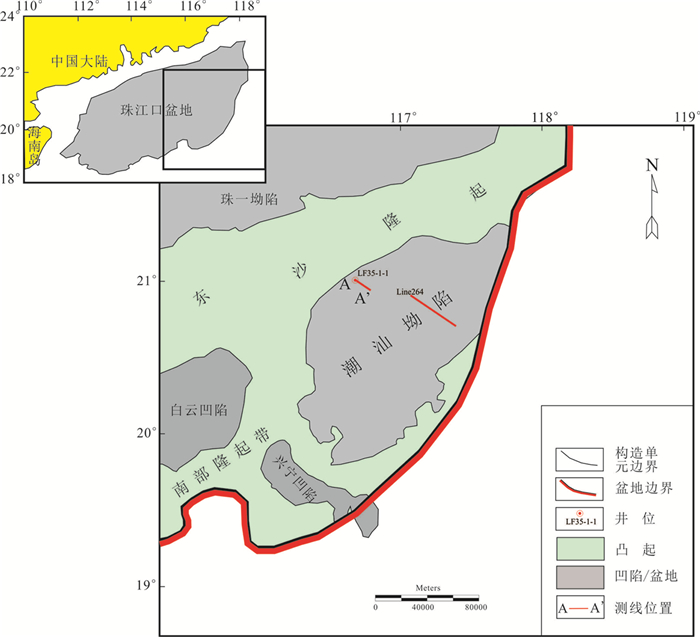
 下载:
下载:
